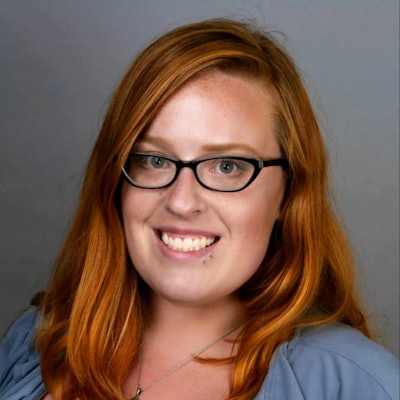Michaela Martin began a two-year degree at a community college in Oregon as a single mom to a young son. But to go to class, she needed someone to help watch her son, so she went to the childcare center on campus to sign him up.
Except there was a two-year waiting list. Her degree program would be finished by then.
“I sat on the curb and cried that day. I didn’t know what to do,” says Martin.
She asked the college for help, but administrators told her that they needed data on how many students had dependents in need of childcare before they could add more spots. Martin did not understand how no one had been counting student parents.
 Michaela Martin
Michaela Martin
Six years ago, as an Oregon State University transfer student, Martin got to work on a bill to help count student parents on annual forms to public universities and community colleges. Senate Bill 564 became law in Oregon in June.
“This started because I felt really alone. The data was a way for me to point to a number and make me feel less alone. That’s all I wanted,” she says.
Oregon is the first state in the U.S. to pass legislation that allows parents to be counted. The bill includes provisions for students who may be parenting stepchildren or siblings and other people who are not their legal dependents. Institutions will share these numbers with the state to then be made public.
Today, Martin is a law student at the University of La Verne and a Student Parent Advisor at Ascend at the Aspen Institute, a nonprofit organization that advocates for college students with dependents.
“It seems as though people are still treating this as a niche issue and not understanding how many pregnant and parenting students there really are,” says Dr. Autumn Green, a research scientist at Wellesley Centers for Women (WCW), where she leads the Higher Education Access for Student Parents Research Initiative. “But parenting students make up about 22% of undergraduates. That is not niche.”
After noticing student parent data gaps in higher education, especially around housing, Green built the online Campus Family Housing Database at WCW. It lists colleges and universities that offer college-affiliated housing where students can live with children. The database, which was last updated in spring 2019, reveals widespread housing gaps.
“If our data is telling us only 6% of colleges and universities offer any opportunity for students to live on campus with their children, then we’re seeing a disparate impact issue,” said Green, who argues that addressing housing needs falls under Title IX protections for parenting or pregnant students.
 Michaela Martin with her son.
Michaela Martin with her son.
“Section 8 requires you to submit 30 days’ notice and leave your place of residence to be in the new city where you are moving,” said Martin, whose son was seven years old at the time. “So I had to leave Oregon and come to L.A. to get my housing voucher. I couldn’t even find out how much of a voucher I would get until I got here.”
Martin’s law school offered students no campus-affiliated family housing that would take her Section 8 housing voucher. So, she and her son lived out of a microwave and a minifridge for weeks. Martin failed one class in law school.
“My parents took out a second mortgage to make it work,” she says. “I’d do homework while searching for an apartment and worrying what would happen when we ran out of money. It was not fine. It was not fine at all.”
But Ascend had heard of Martin’s work on the Oregon bill and called her. They didn’t know about her situation, only that she had been pushing a policy to track student parents. When they asked her to interview to be a student parent advocate, Martin said she cried.
“Knowing then that I might not make it through that semester or any semester, to hear them say, ‘We think you’re awesome,’ I felt, ‘Oh my god, somebody sees me and values me.’ Which was the whole point of the bill, right?” says Martin. “For people to see me and value me and want to hear my voice.”
Institutional partnerships fill the gaps
Some institutions, Green pointed out, stand out as models in working to better support student parents. Ohio State University (OSU)’s ACCESS Collaborative program, for example, offers wraparound services for students with families to make it to graduation.
“Our mission is to break the cycle of poverty one degree at a time,” says Traci Lewis, assistant director of OSU’s ACCESS Collaborative. Most ACCESS Scholars are women of color, as are most student parents in the country. “Because we know that if we can get mom her degree, the likelihood of her children doing the same is very good.”
 Autumn Green
Autumn Green
A partnership between the House and the Columbus Metropolitan Housing Authority allows all residents to qualify for Section 8 housing vouchers. YMCA of Central Ohio also offers affordable, on-site childcare through another partnership.
“Many of the students either do not pay rent or pay a very small amount compared to market rate, which takes a huge load off of them,” says Lewis. “Now they have stable housing that they can afford with childcare that allows them to focus on school.”
ACCESS Scholar Kati Gibson is majoring in biomedical engineering at OSU while caring for her 10-year-old son, who has autism and attention-deficit hyperactivity disorder. Gibson completed her associate degree before OSU, but she almost dropped out until she moved into Columbus Scholar House.
“I had my son two weeks after I graduated from high school, and I was struggling with working and going to school for my associate degree,” Gibson says. “It was time-consuming with extra school meetings and therapies for my son. I was burned out. It wasn’t going to be doable for me to work and stay in school. So, I called Scholar House when I realized there was no other way for me to continue my education without it.”
Gibson has been a Scholar House resident for three years. She started at OSU two years ago after finishing her associate degree.
“It made a huge difference to have the housing security to focus on school and not have my attention divided in so many ways,” she says. “Childcare especially has made a difference. The income limit is so low for government assistance, and childcare is so expensive that you can end up in the middle of the road, not able to get help or be able to afford it.”
Yet the pandemic has made balancing school and parenting harder as Gibson homeschools her son with disabilities. She says that the support at Scholar House and ACCESS has helped.
“We have a Scholar House group chat where we try to help each other. A lot of posts are things like ‘I’m out of milk, can I borrow some?’ Or asking which classes to take,” says Gibson, who wants to pursue a career in designing prosthetics after she graduates. “I feel like I have the potential for a successful future now because of the community here. And because I can go to Traci for help.”
She has noticed a difference in her son as well since living at Scholar House and being part of ACCESS.
“When I had all those things going on — school, work, his meetings and therapy — I felt like we didn’t have a lot of time to connect, and I think he suffered for that,” says Gibson. “Now I’m not being mentally pulled in all these directions. I’m able to be more mindful of how I’m acting and what he needs, especially with the community he has with other kids at Scholar House. He has his own friends here. I think that’s been great for him.”
Supporting students and their families
Gibson stresses the importance of student parents programming that is relevant to their needs given their busy schedules, especially in a remote environment with the pandemic. Lewis agrees.
“I always tell my students that this is not my program, this is your program,” says Lewis, who asks students for feedback on what workshops to offer, like how to make a budget or how to potty-train a toddler. “I don’t want to do things that I think you want. I want to do things I know you want, and the only way I know is if you tell me.”
The University of Oregon is also working on student parents’ housing needs to be inclusive. Francis Pastorelle, assistant director of residence life at the university, says that family housing has been available on campus since World War II soldiers returned and started coming to campus with families. Since then, three childcare centers have opened on campus as well.
“I’m collaborating with our nontraditional student programs, such as our veteran students and our international students,” says Pastorelle. “But the whole concept of a nontraditional student is outdated from the start. Because what is traditional exactly? These older, so-called nontraditional students with kids will become more and more the norm.”
He added that Oregon’s new bill to count student parents at universities should help housing programs on campuses in the state.
“Because if you know that a certain percentage of students have families, then you’ll have more incentive to build that housing,” says Pastorelle. “But even if you don’t have that data, you could build housing that could be attractive to families.”
Pastorelle pointed out that a new residential building that is still under construction will have apartment-style suites. Such units will likely appeal to graduate students and nontraditional students without families. Yet by drawing these students to the new suites, Pastorelle said that he hopes family-friendly housing at the university will then be more available to student parents.
“I also think helping student parents know what resources are available takes extra work on the part of the university to be intentional,” he says. “We’re not just going to put a flyer up. We need campus partners to come and talk about their programs with families.”
Yet remote or hybrid programming in the pandemic has made this kind of outreach tougher.
“Any housing and childcare needs should be multiplied by ten because of the pandemic,” says Pastorelle. “I don’t know any other group that has been impacted more than college students with kids. Folks working with student parents should be sensitive to what a difficult year this has been.”
Likewise, Lewis shares advice for institutions looking to support student parents, again stressing the importance of data collection.
“The first thing they need to do is figure out how many student parents are on campus,” says Lewis. “Once they have that information, pull students together and have them help you talk about what they need. Then survey your campus to find out what resources you have and what you can do immediately that won’t take too much money.”
To Lewis, that last step depends on building relationships with departments. A few months ago, Lewis asked OSU’s libraries if they had space where children could spend time near parents while they studied in the library.
“They had an area that they weren’t using much close to the computers, so we turned that into a children’s spot with books for them while mom or dad does homework,” says Lewis. “For other schools, it could be as simple as pulling together online resources that show family-friendly spaces on campus. That’s where I would start.”
There is a long way to go in helping student parents, but institutions taking the lead in counting is a key part of moving forward, says Green.
“Even institutions that have some of the largest student parent housing programs in the country often have waiting lists and not enough units,” says Green. “From an equity perspective, if 20% of your students are parents in need of housing, then 20% of your housing should be for those students. But we’re not seeing that yet.”
Oregon’s latest bill is a promising start to Martin, who remains determined to make an impact.
“This isn’t new, and it’s not just a couple of people,” she says. “It doesn’t cost that much to add a data bucket. It’s not egregious. It may be a circular logic: To prove that we need to have data, we need data. I think people need to grasp that. I’m going to ring this bell until I’m blue in the face. Count us.”
This article originally appeared in the October 14, 2021 edition of Diverse. Read it here.



















